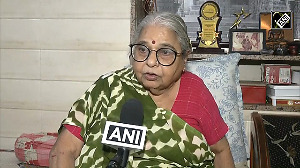The second Tarapore Committee on capital account convertibility is unlikely to aggressively push for the full float of the rupee at this juncture. The committee will submit its report to the Reserve Bank of India on Monday.
Bankers feel that the committee may link the road to full convertibility of the rupee to lowering of fiscal deficit. They also say a lower inflation rate will hold the key to making the rupee full float.
India has made considerable progress in cutting the fiscal deficit of the central government. It has fallen from 5.9 per cent of GDP in 2002-03 to 4.1 per cent last year.
However, the combined deficit of states and the Centre was estimated to be 7.7 per cent in 2005-06. The RBI has projected an inflation rate band of 5-5.5 per cent for this year.
The RBI had set up the committee in March after Prime Minister Manmohan Singh asked the central bank to consider a new roadmap on convertibility.
Other members of the committee are Surjit S Bhalla, MG Bhide, RH Patil, AV Rajwade and Ajit Ranade.
Tarapore also headed an earlier committee on CAC in 1997.
One of the terms of the committee is to provide a comprehensive medium-term operational framework, with sequencing and timing, for "fuller" CAC after taking into account the revenue and fiscal deficit of both Centre and states.
The mandate also includes examining implications of "fuller" capital account convertibility on monetary and exchange rate management.
"As you have noticed, the panel has been asked to lay the road map for 'fuller' convertibility. This itself shows the gradualism of the approach. We do not expect a definite, near-term time-table for making the rupee full float," said the chief financial officer of a large corporate.
Apart from the critical fiscal deficit and inflation targets, most of the preconditions laid down by the first Tarapore report have been met, including those concerned with debt service repayments, volatile capital flows, such as short-term debt and portfolio investments, and a minimum net foreign assets to currency ratio.
Under the Tarapore-I parameters, the ideal pile of foreign exchange reserves varied between $22 billion and $30 billion. India's foreign exchange reserves are now $163 billion.
Tarapore-I had suggested that short-term debt and portfolio investments by foreign institutional investors should be 60 per cent of the reserves or even lower. Currently, it is around 37 per cent of the reserves.
The net foreign exchange assets to currency ratio is around 150 per cent now against the Tarapore-I precondition of not less than 70 per cent.
The panel was also in favour of the 10th Finance Commission recommendation of setting up a consolidated sinking fund for public debt. This has not yet been done. However, the Fiscal Responsibility and Budget Management Act, which the panel had pitched for, is in place.
The committee was in favour of greater independence for the RBI and an average mandated inflation rate of 3-5 per cent. The average inflation rate in 2005-06 was 4.45 per cent but no mandate has been given to the central bank for inflation control.
Sanjeev Sanyal, senior economist of Deutsche Bank, says the targets have shifted over the past decade and the RBI would need around $300 billion worth of reserves today for a credible war-chest.
In one of his recent speeches, RBI Deputy Governor Rakesh Mohan said the impact of a freely floating exchange rate in developed countries was different from an emerging economy like India and hinted that the central bank might not like to loosen its grip over the rupee.





